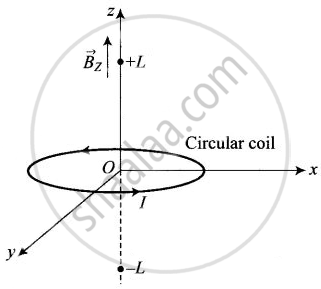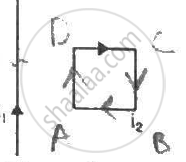Advertisements
Advertisements
प्रश्न
Consider a circular current-carrying loop of radius R in the x-y plane with centre at origin. Consider the line intergral
`ℑ(L ) = |int_(-L)^L B.dl|` taken along z-axis.
- Show that ℑ(L) monotonically increases with L.
- Use an appropriate Amperian loop to show that ℑ(∞) = µ0I, where I is the current in the wire.
- Verify directly the above result.
- Suppose we replace the circular coil by a square coil of sides R carrying the same current I. What can you say about ℑ(L) and ℑ(∞)?
उत्तर
Magnetic field due to a circular current-carrying loop lying in the xy-plane acts along z-axis as shown in figure.
a. B(z) points in the same direction of z-axis and hence ℑ(L) is monotonical function of L as B and dl are long in the same direction.
So B.dl = Bdl cos θ = Bdl cos θ° = Bdl
∴ ℑ(L) is monotonically increasing function of L.
b. Now consider as Amperean loop around the circular coil of such a large radius that L → `oo`. Since this loop encloses a current I, Now using Ampere's law
`ℑ(oo) = oint_(-oo)^(+oo) vec(B) * vec(dl) = mu_0I`
c. The magnetic field at the axis (z-axis) of circular coil is given by `B_z = (mu_0IR^2)/(2(z^2 + R^2)^(3/2)`
Now integrating
`int_(-oo)^(+oo) B_z dz = int_(-oo)^(+oo) (mu_0IR^2)/(2(z^2 + R^2)^(3/2)) dz`
Let z = R tan θ so that dz = R sec2 θ dθ
And `(z^2 + R^2)^(3/2) = (R^2 tan^2 theta + R^2)^(3/2)`
= `R^3 sec^3θ (as 1 + tan^2θ = sec^2θ)`
Thus `int_(-oo)^(+oo) B_zdz = (mu_0I)/2 int_(- pi/2)^(+ pi/2) (R^2(R sec^2 θ dθ))/(R^3 sec^3θ)`
= `(mu_0I)/2 int_(- pi/2)^(+ pi/2) cos θ dθ = mu_0I`

d. As we know `(B_z)_("square") < (B_z)_("circular coil")`
For the same current and side of the square equal to radius of the coil
`ℑ(oo)_("square") < ℑ(oo)_("circular coil")`
By using the same argument as we done in case (b), it can be shown that `ℑ(oo)_("square") < ℑ(oo)_("circular coil")`
APPEARS IN
संबंधित प्रश्न
Two concentric circular coils X and Y of radii 16 cm and 10 cm, respectively, lie in the same vertical plane containing the north to south direction. Coil X has 20 turns and carries a current of 16 A; coil Y has 25 turns and carries a current of 18 A. The sense of the current in X is anticlockwise, and clockwise in Y, for an observer looking at the coils facing west. Give the magnitude and direction of the net magnetic field due to the coils at their centre.
Two identical circular coils, P and Q each of radius R, carrying currents 1 A and √3A respectively, are placed concentrically and perpendicular to each other lying in the XY and YZ planes. Find the magnitude and direction of the net magnetic field at the centre of the coils.
A circular loop is kept in that vertical plane which contains the north-south direction. It carries a current that is towards north at the topmost point. Let A be a point on the axis of the circle to the east of it and B a point on this axis to the west of it. The magnetic field due to the loop
Consider the situation shown in figure. The straight wire is fixed but the loop can move under magnetic force. The loop will

Two circular coils of radii 5.0 cm and 10 cm carry equal currents of 2.0 A. The coils have 50 and 100 turns respectively and are placed in such a way that their planes as well as the centres coincide. If the outer coil is rotated through 90° about a diameter, Find the magnitude of the magnetic field B at the common centre of the coils if the currents in the coils are (a) in the same sense (b) in the opposite sense.
Find the magnetic field B due to a semicircular wire of radius 10.0 cm carrying a current of 5.0 A at its centre of curvature.
A circular loop of radius r carries a current i. How should a long, straight wire carrying a current 4i be placed in the plane of the circle so that the magnetic field at the centre becomes zero?
A charge of 3.14 × 10−6 C is distributed uniformly over a circular ring of radius 20.0 cm. The ring rotates about its axis with an angular velocity of 60.0 rad s−1. Find the ratio of the electric field to the magnetic field at a point on the axis at a distance of 5.00 cm from the centre.
The magnetic field at a distance r from a long wire carrying current I is 0.4 tesla. The magnetic field at a distance 2 r is ______.
